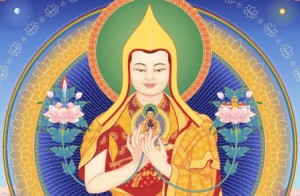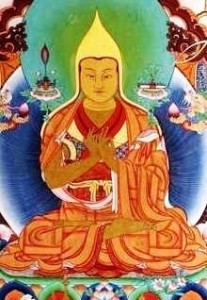The following is respectfully quoted from “Compassion in Tibetan Buddhism” by Tsong-ka-pa
The fourth of the seven cause and effect precepts is love. The field of observation is all sentient beings, and the subjective aspects are three:
- How nice it would be if all sentient beings had happiness and its causes.
- May all sentient beings have happiness and its causes.
- I will cause all sentient beings to have happiness and its causes.
These are three levels of increasing strength which should be cultivated gradually until the point of spontaneity is reached.
The King of Meditations Sutra (Samadhiraja) says that the benefit of cultivating love with all sentient beings as the field of observation is immeasurably greater than that of offering to Buddhas and Bodhisattvas over many aeons even lands filled with food, drink, and articles. The Sutra of Manjushri’s Buddha Land (Manjushribuddhak shetra) says that there is a Buddha Land to the north-east of this world where beings have attained cessation of coarse feelings and discriminations, abiding most comfortably in meditative stabilization without suffering. Being so happy, they find it easy to behave purely, not killing, stealing, engaging in sexual misconduct, and so fort, for many thousands of ten millions of years. The sutra says that although the benefit of their practice is great, it is more beneficial to cultivate love here for the time it takes to snap the fingers.
One should first take as the object of observation a friend and cultivate the wish that this person have happiness. When this becomes easy, one should consider a neutral person and cultivate the wish as before. Then, one should consider an enemy and cultivate love until there is no difference between the wish for happiness that one has for the friend, the neutral person, and the enemy. The meditation should be extended slowly to all sentient beings throughout space, reflecting again and again on the disadvantages of not have the advantages of having happiness. One may then gradually ascent through the three subjective aspects.
Even if one meditates only for five minutes taking cognizance of all sentient beings and if even the love consciousness, due to unfamiliarity is weak, the virtue is inconceivable because the scope is so vast. For example, if a sesame seed is squeezed, only a little oil comes out, but if many are squeezed, a barrel can be filled with oil.
Initially the meditation should not be longer than fifteen minutes in order to avoid fatigue and retain enthusiasm. Later, it can be lengthened until immeasurable love, conjoined with meditative equipoise, is eventually attained. When love is cultivated little by little, very clearly, with all beings as the field of observation, it is as if one is repaying in part the immeasurable kindness that others have extended in former lifetimes.
The next step is to cultivate compassion. The field of observation of a compassionate mind is all sentient beings who have any of the three types of suffering – of pain, of change, and of being so composed as to be always ready to undergo pain.
The suffering of pain is actual physical or mental discomfort including in which are birth, aging, sickness and death. Many billions of years have passed since this world was formed; many have been born here, but there is no one who has managed just to stay alive. It is necessary to die and take rebirth again and again.
Sufferings of change are feelings of pleasure which, when superficially considered, seem to be pleasurable but can change into suffering. For example, if a person is out in the sun where it is too hot, he is pleased to go to a cooler spot, but if he stays there too long, he will become cold and sick. Similarly, when one becomes too cold and then goes to a hot place, if one gets too hot, one will fall sick. Although there is seeming pleasure in becoming cooler or warmer, if one stays in that state too long, it turns into suffering. This shows that these situations do not have an inherent nature of pleasure.
Similarly, in this world of beings–whether animal or human–mate with pleasure, but if it is not done in a moderate amount, the pleasure is lost. Excessive copulation can cause a disease called “cold and wind” in the lower abdomen, harming both male and female genitals. Though enjoyable at first, it can ruin the very basis of comfort in the vital channels (nadi). Thus, these feelings of pleasure are said to be contaminated and are called sufferings of change.
The third type of suffering is called that of pervasive composition. Whenever a sentient being takes birth by the power of contaminated actions and afflictions in the desire, form, or formless realms, there are periods when he does not have manifest suffering. However, if certain conditions aggregate, suffering will be generated because the basic causes misery pervade all types of life within the three realms. For instance, though one might have no manifest suffering now, if one is pricked with a needle, cut with a knife, or kicked, pain is immediately produced.
The field of observation for the compassionate mind is all sentient beings who have these three types of suffering; however, to understand the suffering of others, it is necessary first to know the immeasurable fault of one’s own birth in cyclic existence. One should think:
I have engaged in non-virtue since beginningless time and have accumulated bad actions (karma). I suffer pain and change. I am afflicted by being always liable to suffer pain.
One should contemplate the causes of suffering–the ten non-virtues, how one has engaged in them, and how one has suffered in this lifetime. There are three physical, four verbal, and three mental non-virtues.
PHYSICAL NON-VIRTUES
- Killing: taking the life of a human or any other being. If one has committed murder, one is born in a bad migration, and then when the migration is finished, even if one is reborn as a human, the lifespan will be very short.
- Stealing: taking what is not given. Through its force one will have few resources in the future, and whatever one has others will steal.
- Sexual misconduct: incest, copulation in the presence of an image that is an object of refuge, or with a woman about to give birth, and so forth. Such misconduct leads to being controlled by desire and hatred in the future.
VERBAL NON-VIRTUES
- Lying: saying what is is not, that what one does not have one has, or the opposite. From such deception one will not hear the truth in the future.
- Divisiveness: creating dissension between people or increasing dissension that already exists. The fruit of dividing people is that one will not have friends and will hear oneself frequently faulted by others.
- Harsh speech: speaking from anger in order to harm. For instance, when directing someone to go here or there, one does not speak politely but says, ‘Can’t you get over here?!’ The effect is that one will be reborn in a place where one must always be scolded.
- Senseless talk: conversation that is not about religious practice, the affairs of one’s family or country, but about meaningless subjects. Through wasting one’s life unsconscientiously in meaningless talk one will not hear sensible talk in the future and will be reduced to speaking gibberish.
MENTAL NON-VIRTUES
- Covetousness: the desire for acquisition upon seeing the property of another person. This causes poverty and leads to losing whatever property one has.
- Harmful intent: the wish to injure another, male, female, animal and so forth. Based on this deed, people will not be agreeable in the future.
- Wrong views: asserting that the cause and effect of actions do not exist, that the Three Jewels are not sources of refuge, and the like. If due to such views one perversely holds that there is no fault in engaging in the three physical or four verbal non-virtues, this harms the roots of virtue already formed in one’s mental continuum and thereby induces great suffering in the future.
One should gradually call to mind one’s own non-virtues and reflect on the cause and effect process that induces suffering. It is appropriate to generate contrition, a sense of discomfort with former misdeeds, and a promise to refrain from those deeds henceforth.
Reflection on one’s own involvement in the causes of suffering ultimately generates an intention to leave cyclic existence. One comes to know that just as one has suffered in this lifetime, after death the process will begin again and wherever one is born–even as a god or a human, oe must suffer. Having formed a clear sense of one’s own situation, one should then consider a friend:
This person has the three types of suffering and is also engaging in the causes the further misery. Even when he finishes undergoing the suffering of this lifetime, he will have more in the next. How nice if he were free from suffering and its causes! May he become so! I will cause him to become so!
Then one should consider a neutral person and after that an enemy. Gradually and over a long period of time, one can slowly extend the meditation to all sentient beings.
Having developed facility first with respect to a friend, such as one’s mother, one is able to measure the progress with respect to neutral persons and enemies by comparing it to the strong feeling for the friend. Why should one make all neutral persons and enemies equal to one’s mother? If she had fallen into a ravine or a river, or into a chasm made by an earthquake, and if her own child whom she had helped from the time of his entry into her womb would not help her, who would?

